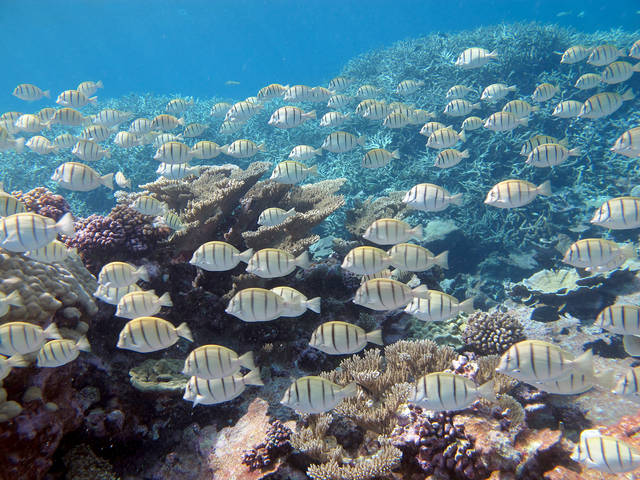Reef fish making comeback in Hawaii Island
Just two years into a 10-year rest period at the Ka‘upulehu Marine Reserve on the North Kona coast of Hawaii island, fish populations are beginning to respond, with some species increasing more than 60 percent, according to recent dive surveys by The Nature Conservancy.
“We’ve been hearing from long-time fishermen that the area is starting to remind them of ‘old Hawaii,’” said Leina‘ala Lightner, a lineal descendant of Ka‘upulehu and curator of the Ka‘upulehu Interpretive Center at Kalaemano. “Divers who came to our invasive fish removal event last summer said they were seeing big schools of weke, pualu, uhu and manini, as well as healthy coral, limu, ‘opihi and wana. Many of them shared that seeing the recovery completely changed their opinion of the rest area and community-based fishery management.”
Chad Wiggins, Hawaii Island marine program director for TNC, said the organization’s 2018 surveys supported what community members were seeing.
“On more than 183 dives over seven miles of coastal reefs, we observed more fish — fish we hadn’t seen in the area before — and bigger fish,” he said. “While it is too early to determine the long-term effects of the rest area, these signs of recovery show promise for the community’s goal of supporting a sustainable subsistence fishery in the region.”
Baseline surveys conducted from 2009-2016, before the rest area period began, demonstrated no difference in reef fish communities inside and outside the rest area. But an analysis of TNC’s September 2018 monitoring data shows that populations of some resource fish, including prized species of wrasses, parrotfish and surgeonfish, are increasing, and that increases inside the rest area are higher than in adjacent areas. Specifically, the surveys found:
• 62 percent increase in some wrasses (i.e., hogfish) inside the rest area, and 3 percent outside;
• 30 percent increase in some parrotfish (i.e., uhu) inside the rest area, and 3 percent outside;
• 46 percent increase in some surgeonfish (i.e., kole) inside the rest area, and 21 percent outside;
• Evidence of spillover, or fish populations increasing, just outside the reserve boundary.
In addition, coral surveys documented stable or slightly increasing coral cover following the mass bleaching event in 2015-2016 that saw high ocean temperatures kill an average of 50 percent of the coral in West Hawaii. This is another indicator that reducing impact on an area can help promote reef resilience.
“The reef resilience survey findings we completed last year showed that reefs with the most recovery from the coral bleaching events are in areas with limited exposure to human impacts,” said Wiggins. “Resilient reefs can resist or recover from stressors such as warmer ocean temperatures, land-based pollution, or high fishing use.”
The initiative to rest the reefs of Ka‘upulehu was dubbed “Try Wait” and led by the Ka‘upulehu Marine Life Advisory Committee comprised of kupuna, Office of Hawaiian Affairs, Kamehameha Schools, Kona Hawaiian Civic Club, and local kamaaina, landowners and lineal descendants who have been observing fish declines for decades.
In 2009, they invited scientists from TNC to conduct coral reef and fish surveys at Ka‘upulehu and neighboring Kuki‘o. TNC’s scientific monitoring documented decreases in important food fish community members were observing. The community led a rule-making process to rest the reef for 10 years to replenish depleted fish stocks to levels that could support sustainable harvest. After numerous public meetings, the state Department of Land and Natural Resources created the Ka‘upulehu Marine Reserve in July 2016.
“This is preliminary data and these fish have a long way to go before they are fully recovered,” said Dr. Eric Conklin, Hawai‘i director of marine science for TNC. “But after decades of documenting decline for highly prized food fish like uhu (parrotfish) that are so important in keeping reefs healthy, it’s a big step in the right direction.”

